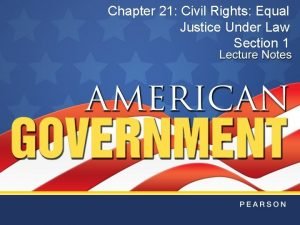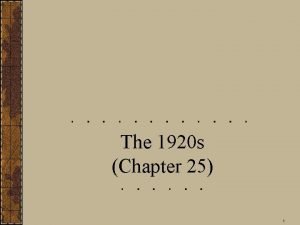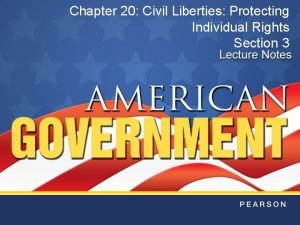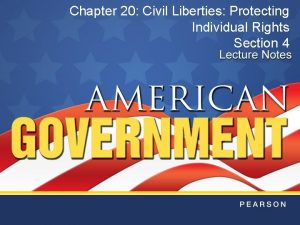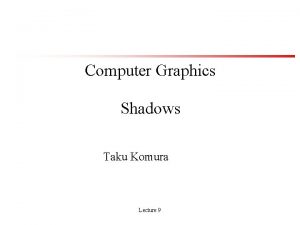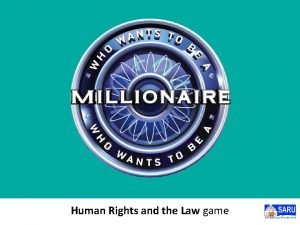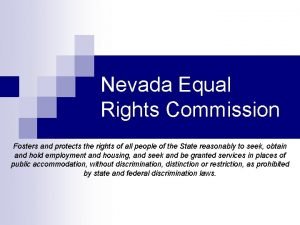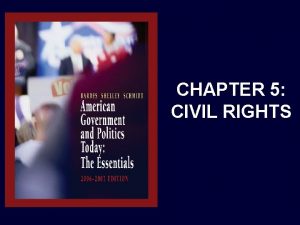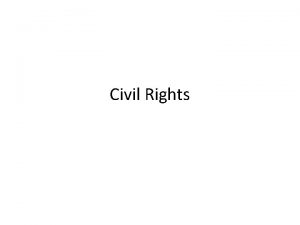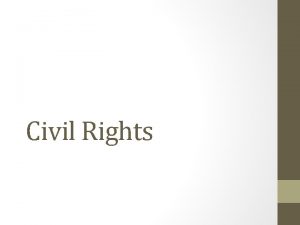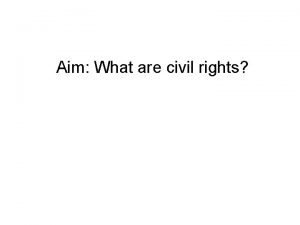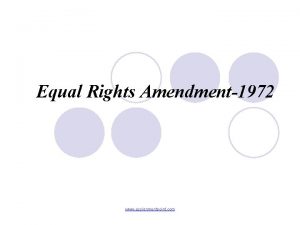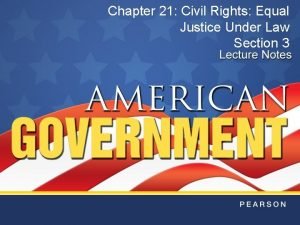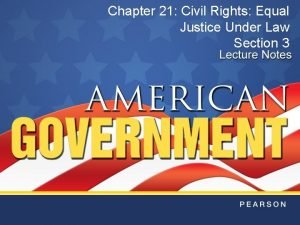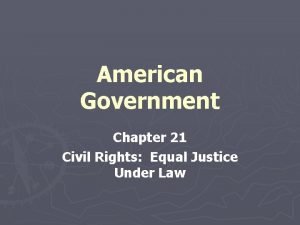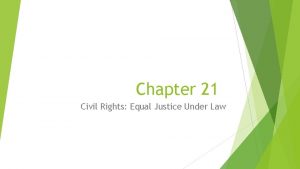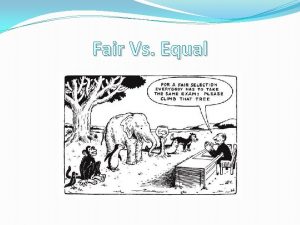Chapter 11 Civil Rights Section 2 Equal Justice













- Slides: 13

Chapter 11: Civil Rights Section 2: Equal Justice Under Law (pgs. 325 -332)

Equal Protection of the Law • Much of the progress against discrimination has been made in the courts. • Over time, judges have used the equal protection clause of the 14 th Amendment to ban discrimination by the government and to extend equal protection of the law.

The Equal Protection Clause • The Equal Protection Clause is in the 14 th Amendment and says “No State shall…deny to any person within its jurisdiction the equal protection of the laws. ” • This was passed after the Civil War to protect newly freed slaves and was directed at the states. • This was new b/c up to that point the Bill of Rights protected people from the federal government. • Over time the Supreme Court has interpreted the clause in way that prevents states from classifying any group of people unfairly. • T/f the 14 th Amendment’s Equal Protection Clause is one of the main sources of civil rights today.

Reasonable Distinction • The government is able to distinguish between different groups of people. • For example it can charge visitors that go to state parks and not charge non-visitors. • However, the government cannot make a distinction between people with green eyes or red hair. • Federal courts use 3 guidelines to decide if the government has made fair distinctions, between groups. • They are the rational basis test, intermediate scrutiny test, and strict scrutiny test.

Rational Basis Test • Rational means good reason. • Treating groups differently is valid under the rational basis test if the law in question establishes reasonable methods of accomplishing a legitimate goal of government. • The example that the book gives is the minimum age , 16, for driving a car b/c the courts have said people below this age may not have enough experience and maturity.

Intermediate Scrutiny Test • Sometimes courts impose a higher standard to determine if laws violate the equal protection clause. • For example, the intermediate scrutiny test has been used in cases involving classifications based on sex. • In this case the courts have said it is ok for only men to register with the Selective Service, not women.

Strict Scrutiny Test • This is the highest standard. • It is applied when 1) a fundamental right is being restricted such as the right to free speech or the right to vote, or 2) a classification is made based on race or national origin. • A classification based on race or national origin is called a suspect classification. • The government must show that there is “a compelling reason” that is in the public interest for the group classification. • An example of this is the 1967 case Loving v. Virginia that allowed whites and blacks to marry in Virginia. This Virginia law failed to meet the test.

Laws & Segregation after the Civil War • After the Civil War, the 13 th, 14 th, & 15 th, amendments were passed to protect the newly freed slaves, during Reconstruction. • Also, the federal government passed a series of Civil Rights laws during this period. • Unfortunately, after 1877 states started to pass laws against African-Americans. • This was in direct violation of the new constitutional amendments and laws. • T/f, adding new words to the Constitution , it turned out was not enough to transform society and create true equality.

Racial Segregation • Between 1865 -1877 African Americans were able to participate in the political process. • Then the Compromise of 1877. • Then the KKK used violence to keep blacks from pursuing their Civil Rights. • Eventually, southern governments started passing segregation laws, known as Jim Crow laws. • These laws separated the races in almost everything. , from schools to bathrooms.

Permanent Segregation • Whites controlled the government to the point that blacks had no protection under the law. • The Supreme Court ruled in favor of the Jim Crow laws in 1883, when they ruled against the Civil Rights Act of 1875. • Then in 1896, the Supreme Court ruled in Plessy v. Ferguson that segregation was legal as long as it was separatebut –equal.

Voting Rights for Women • The 1 st leaders were Elizabeth Cady Stanton, Lucretia Mott, and later Susan B. Anthony. • They held a convention at Seneca Falls in 1848. At the convention they adopted a Declaration of Sentiments based on the D. of I. • Despite these early calls for women’s suffrage, the 15 th amendment only gave black men the right to vote. • It took activists marching, picketing, and hunger strikes to get the attention of the men in the U. S. • Western states began to give the right to vote but it was not until 1920 that the 19 th amendment passed and women could vote in all elections.

Rolling Back Segregation • Plessy had laid the foundation for de jure segregation or segregation by law. • In 1909 some African Americans formed the NAACP and this group began to fight segregation in the courts. • By the 1930 s the groups top lawyer Thurgood Marshall started to win a series of cases that began to cut into segregation. • The biggest case came in 1954, Brown v. The Board of Education of Topeka, Kansas.

School Desegregation • After the Brown ruling, the Supreme Court ordered schools to end segregation “with all deliberate speed. ” • 1957 Little Rock Nine, the president had to sent 1, 000 federal troops. • Many schools did not end segregation until the 1970 s…example Waco ISD. • De fact segregation still happens because of housing patterns, which effects school attendance.
 Chapter 21 civil rights equal justice under law
Chapter 21 civil rights equal justice under law Civil rights and civil liberties webquest
Civil rights and civil liberties webquest Chapter 20 civil liberties protecting individual rights
Chapter 20 civil liberties protecting individual rights Chapter 14 postwar prosperity and civil rights
Chapter 14 postwar prosperity and civil rights La raza apush
La raza apush Chapter 20 civil liberties protecting individual rights
Chapter 20 civil liberties protecting individual rights Chapter 20 civil liberties protecting individual rights
Chapter 20 civil liberties protecting individual rights Equal height equal light
Equal height equal light Equal height equal light
Equal height equal light Equal sharing or grouping is called
Equal sharing or grouping is called Sides opp. equal ∠s
Sides opp. equal ∠s Equal area vs equal angle stereonet
Equal area vs equal angle stereonet The basic of human rights
The basic of human rights Kara jenkins nevada
Kara jenkins nevada
